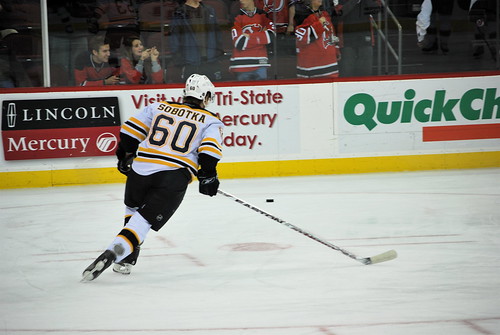Flames goalie prospect Wolf vows to be ready when his time comes
Vladdy #Vladdy

One of the top prospects in the hockey world will remain in the American Hockey League – at least to start the NHL season.
Dustin Wolf, the Calgary Flames’ seventh-round pick (No. 214) in 2019, has accomplished seemingly everything at the American Hockey League level. He’s won the AHL’s outstanding goalie of the year award twice (2021-22 and 2022-23) and last season he was also named the league’s most valuable player after winning 42 games and posting a .932 save percentage and a 2.09 goals-against average with the Calgary Wranglers.
The 22-year-old made his NHL debut in the Flames’ final game of last season, stopping 23 of 24 shots in a 3-1 win over the San Jose Sharks.
Despite those accolades, however, his odds of making this year’s opening-night roster were slim given the Flames’ goaltending depth at the NHL level, which includes 33-year-old veteran starter Jacob Markstrom and 26-year-old backup Dan Vladar. So far this preseason, Wolf has an .864 save percentage in nearly 81 minutes of action. He is waiver-exempt and can be recalled and sent down without the risk of another team claiming him.
Calgary has made it clear they will not carry three goalies on their NHL roster, so Wolf is looking forward to working on his game more with the Wranglers.
“If they do send me down, it’s just another opportunity for me to get better and me to continue to show them that I want to play at the highest level and I can play here,” he said.
“Wherever I’m playing, go there and give the team a chance to win and just go focus on my game.”
Wolf said he hasn’t spoken with head coach Ryan Huska or general manager Craig Conroy about when he might find himself in another NHL game. Huska made it clear that Wolf is a good netminder who will eventually get his shot at the next level.
“Sometimes, it’s just harder to break in in those situations,” Huska said.
“It’s just making sure he’s consistent, making sure his angles are good, but trusting that he is an elite goaltender.”
Wolf has appreciated the mentorship from Markstrom and Vladar, saying he has always felt comfortable going to either of them if he had any questions.
“It’s good to have two other guys you’re really good friends with and can chat back and forth with,” the native of Gilroy, Calif., said.
“Marky’s been outstanding since he’s been here and I’ve been here. Even Vladdy. Everybody’s super communicative and everybody talks to one another.”
Markstrom is coming off a campaign where he registered an .892 save percentage and a 2.92 GAA and lacked the consistency of seasons past, but looks refreshed and calmer now than he did at the end of last season.
“We’re going in the right direction,” he said.
“You can see it in practice. We are where we need to be and I think we can take a few more steps in these last practice days.”
The team will approach defending in front of Markstrom, Vladar, and Wolf in a very different manner.
During the 2022-23 campaign, the Flames were 25th in five-on-five high-danger save percentage and 31st in five-on-five save percentage overall. Often, they looked disorganized and incohesive in front of their goalies. To improve those numbers, Huska has changed the Flames approach from man-on-man (where each player chooses an opponent to cover in the defensive zone and tries to follow them on the ice) to a zone system where the defensive zone is divided into different zones that each player is responsible for. Zone play allows for more layers, but requires more communication.
“There’s certain talented players out there that, if you’re going to consistently go man on man with them, you’d better have an elite player that’s able to defend that person,” Huska explained, referencing basketball and how talented players in that sport are so tough to guard one-on-one.
“It’s just a way where we can do a good job protecting the middle of the ice.”
The Flames do have one of the league’s best defensive centres in Elias Lindholm, who will be key in limiting those quality chances against.
“The D are staying low and the forwards are closer to the blueline and the centres can play in the middle,” he explained.
“The D are staying low the whole time. It’s a lot of work on the centres, but we’re all in good shape, so it should be fine.”
“This year, there’s going to be a lot more switching [coverage in the defensive zone],” defenceman Chris Tanev said.
“You’re never going to be at the blueline chasing a guy, right?”
With those layers, however, come other challenges.
“If there’s a lot of movement [from opposition forwards], you’re going to have to talk a lot,” Lindholm said.
“You can never talk too much…the key is to make Marky see more pucks and be in the shooting lanes so they can’t shoot the pucks.”
Lindholm will be defending the likes of Connor McDavid, Leon Draisaitl, Jack Eichel, and other stars in the Pacific Division this season, but those players present unique challenges.
“McDavid, for example, he’s one of those guys that you can’t go too hard at,” Lindholm explained.
“He’s too fast, too quick. And that’s kind of what he wants. He wants you to be on his back and then he’s going to do a cutback or something and make you look stupid.”
After players figure out that communication, the system could pay dividends.
“Once you get the hang of it,” Lindholm said, “you can anticipate a lot of plays and kill a lot of plays as well. Hopefully once everyone gets the hang of it, we can turn the puck over quicker and go the other way.”